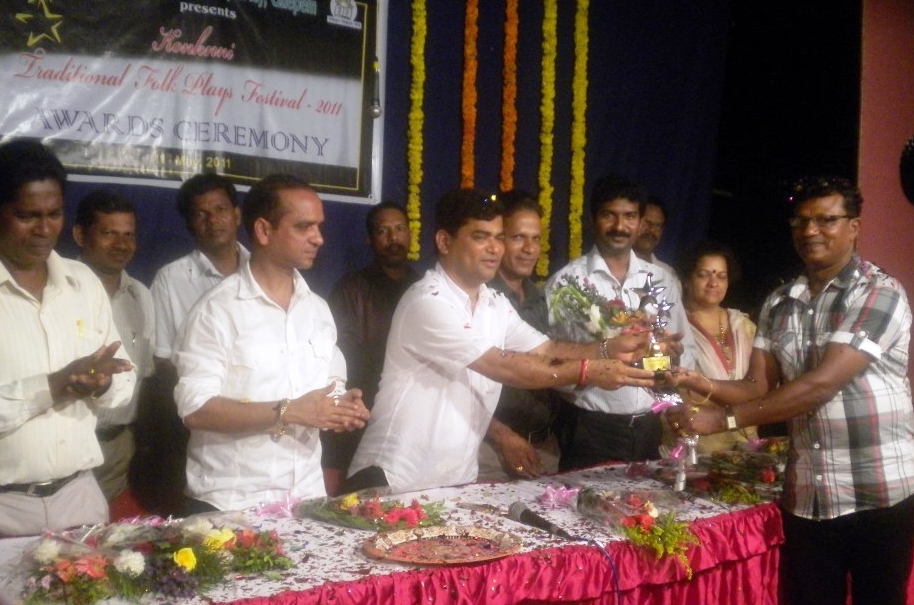Goa is dotted with churches that are lofty, beautiful and are many centuries old. Many are well preserved while others are less fortunate and find themselves in a state of disrepair. Some of the churches which were once unique and timeless have been demolished to make way for a bigger or a newer (mostly newer) church of concrete. Most of the churches that were demolished or are in the process of being demolished were razed due to the ignorance of the lay parishioners to the uniqueness of the structure and also due to the failure of the higher officials of the church (along with the lay parishioners) to recognize its heritage potential and historical value.
Quite close to Old Goa, we find an example of preservation befitting mention wherein the church was renovated and restored and its erstwhile splendor revived: the Church of St. John the Baptist in Carambolim. According to the Archdiocese Directory, 1984, this church was founded in 1541. Originally a chapel, this church was elevated to the status of a parish under the tutelage of Dom João Afonso de Albuquerque (1539-53), the then Bishop of Goa. Fr. Moreno de Souza in Tisvaddecheo Igorzo tells us that during the earlier days the feast of St. John the Baptist was celebrated with much pomp and gaiety with the Viceroy and State and military officials in full attendance. They would enter the parade riding on horsebacks and mock-fights were staged accompanied by music. After the High Mass, the long, regal procession would begin and terminate at the College of St. Paul’s at Old Goa.
The architecture of the façade of the church, informs Jose Lourenço in The Parish Churches of Goa: A Study of Façade Architecture, is in the mannerist Neo-Romanesque style (as are most of the churches in Goa). Standing boldly against the clear blue sky, it has 5 bays and is 3 storeys tall. The center of the façade starting from the main arched doorway is stacked in the sequence of Arch-Rectangle-Oculus-Relief. It has a single bell tower to the left. The main doorway is framed by fluted Corintianized columns.
 |
| The pulpit with 'mermaid' motifs |
The peculiarity of the altar is that it has panels containing paintings depicting various incidents of the life of St. John the Baptist, including his beheading at the insistence of the daughter of Herodias. The main altar is dedicated to the patron saint, while the side altars show a crucified Christ and Mother Mary. The pulpit of this church is unique because the motif of the “mermaids” can be clearly seen. These mermaids are depicted as if they are carrying the weight of the pulpit.
This unique church was in a state of neglect until the charismatic Fr. Conceição D’Silva took the charge as the parish priest from Fr. Lino de Sa, who had already begun the work of restoration by plastering the walls. In his brief tenure of three years, Fr. Conceição, recipient of the State Award for Meritorious Services to Society, completed the whole restoration work giving the church, in the process, a new lease of life. The whole woodwork of the main altar, the subsidiary altars and the pulpit are now richly adorned with 24 carat gold, giving us a glimpse, perhaps, of what the church may have looked like a few centuries ago. Experts for the gold gilding work were flown in from Portugal. Now the church basks in pristine and clear light and the gold is seen shimmering.
The floor was repaired as well, with the specialists, this time, coming from Bangalore. Imported chandeliers from Portugal now adorn the church. Near the transept of the church, an azulejos composition of Leonardo da Vinci’s The Last Supper has been installed.
 |
| Fr. Conceição D'Silva |
The space around the church is paved with pavers and the church compound, the church property and the adjacent football ground have been fenced in stone and cement. The flooring of the Parochial house was also improved. All these improvements, informs Fr. Conceição, is bringing a lot of tourists to Carambolim, many of them genuinely interested in the history and the architecture of the church.
Fr. Conceição is of the frank opinion that the old churches must be preserved and protected. Perhaps, it was this line of thinking which had propelled him to preserve and restore not only the church at Carambolim but also the one at Mandur where he was posted prior to his appointment at St. John the Baptist Church. Fr. Conceição along with the parishioners has spared no expense even for procuring new pews and a state-of-the-art sound system along with the restoration work.
 |
| View of the church |
In a few days’ time, the 1200-plus parishioners of the St. John the Baptist church will bid adieu to a priest who has not only attended to their spiritual needs, but has also given a commendable facelift to their almost five-century old church. It is time that the example set by Fr. Conceição needs to be emulated.
(A version of this article appeared on Gomantak Times, dt: May 27, 2011)






